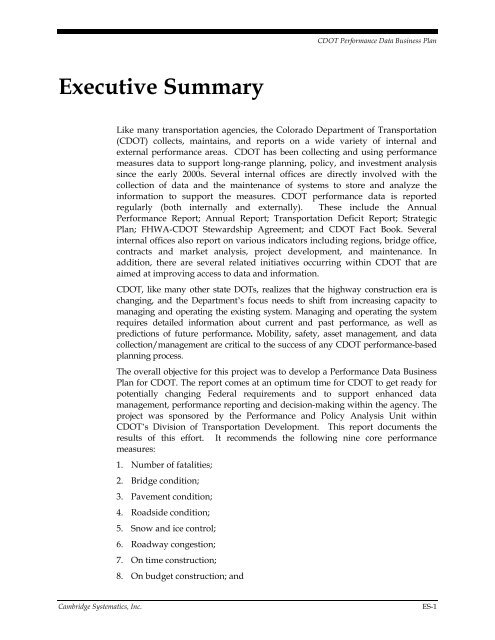CDOT Performance Data Business Plan - Cambridge Systematics
CDOT Performance Data Business Plan - Cambridge Systematics
CDOT Performance Data Business Plan - Cambridge Systematics
You also want an ePaper? Increase the reach of your titles
YUMPU automatically turns print PDFs into web optimized ePapers that Google loves.
<strong>CDOT</strong> <strong>Performance</strong> <strong>Data</strong> <strong>Business</strong> <strong>Plan</strong><br />
Executive Summary<br />
Like many transportation agencies, the Colorado Department of Transportation<br />
(<strong>CDOT</strong>) collects, maintains, and reports on a wide variety of internal and<br />
external performance areas. <strong>CDOT</strong> has been collecting and using performance<br />
measures data to support long-range planning, policy, and investment analysis<br />
since the early 2000s. Several internal offices are directly involved with the<br />
collection of data and the maintenance of systems to store and analyze the<br />
information to support the measures. <strong>CDOT</strong> performance data is reported<br />
regularly (both internally and externally). These include the Annual<br />
<strong>Performance</strong> Report; Annual Report; Transportation Deficit Report; Strategic<br />
<strong>Plan</strong>; FHWA-<strong>CDOT</strong> Stewardship Agreement; and <strong>CDOT</strong> Fact Book. Several<br />
internal offices also report on various indicators including regions, bridge office,<br />
contracts and market analysis, project development, and maintenance. In<br />
addition, there are several related initiatives occurring within <strong>CDOT</strong> that are<br />
aimed at improving access to data and information.<br />
<strong>CDOT</strong>, like many other state DOTs, realizes that the highway construction era is<br />
changing, and the Department’s focus needs to shift from increasing capacity to<br />
managing and operating the existing system. Managing and operating the system<br />
requires detailed information about current and past performance, as well as<br />
predictions of future performance. Mobility, safety, asset management, and data<br />
collection/management are critical to the success of any <strong>CDOT</strong> performance-based<br />
planning process.<br />
The overall objective for this project was to develop a <strong>Performance</strong> <strong>Data</strong> <strong>Business</strong><br />
<strong>Plan</strong> for <strong>CDOT</strong>. The report comes at an optimum time for <strong>CDOT</strong> to get ready for<br />
potentially changing Federal requirements and to support enhanced data<br />
management, performance reporting and decision-making within the agency. The<br />
project was sponsored by the <strong>Performance</strong> and Policy Analysis Unit within<br />
<strong>CDOT</strong>’s Division of Transportation Development. This report documents the<br />
results of this effort. It recommends the following nine core performance<br />
measures:<br />
1. Number of fatalities;<br />
2. Bridge condition;<br />
3. Pavement condition;<br />
4. Roadside condition;<br />
5. Snow and ice control;<br />
6. Roadway congestion;<br />
7. On time construction;<br />
8. On budget construction; and<br />
<strong>Cambridge</strong> <strong>Systematics</strong>, Inc.<br />
ES-1

















